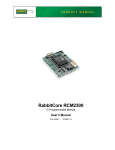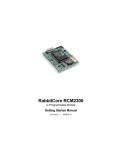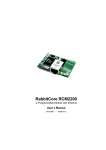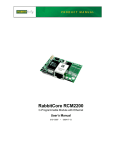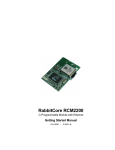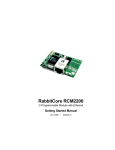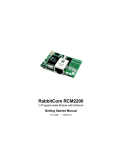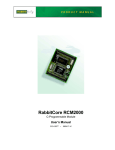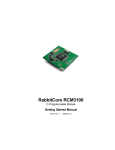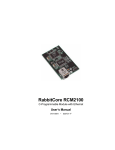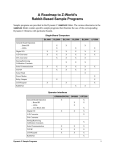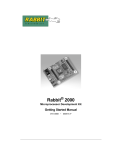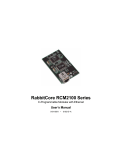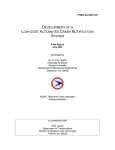Download RabbitCore RCM2300
Transcript
RabbitCore RCM2300 C-Programmable Module User’s Manual 019–0099 • 030731–C RabbitCore RCM2300 User’s Manual Part Number 019-0099 • 030731–C • Printed in U.S.A. © 2001–2003 Z-World, Inc. • All rights reserved. Z-World reserves the right to make changes and improvements to its products without providing notice. Trademarks Rabbit and Rabbit 2000 are registered trademarks of Rabbit Semiconductor. RabbitCore is a trademark of Rabbit Semiconductor. Dynamic C is a registered trademark of Z-World Inc. Z-World, Inc. Rabbit Semiconductor 2900 Spafford Street Davis, California 95616-6800 USA 2932 Spafford Street Davis, California 95616-6800 USA Telephone: (530) 757-3737 Fax: (530) 757-3792 Telephone: (530) 757-8400 Fax: (530) 757-8402 www.zworld.com www.rabbitsemiconductor.com RabbitCore RCM2300 TABLE OF CONTENTS Chapter 1. Introduction 1 1.1 RabbitCore RCM2300 Features............................................................................................................1 1.2 Advantages of the RabbitCore RCM2300 ............................................................................................2 1.3 Development and Evaluation Tools......................................................................................................2 1.4 How to Use This Manual ......................................................................................................................3 1.4.1 Additional Product Information ...................................................................................................3 1.4.2 Additional Reference Information ...............................................................................................3 1.4.3 Using Online Documentation .......................................................................................................3 Chapter 2. Hardware Reference 5 2.1 RCM2300 Digital Inputs and Outputs ..................................................................................................5 2.1.1 Dedicated Inputs ..........................................................................................................................9 2.1.2 Dedicated Outputs ........................................................................................................................9 2.1.3 Memory I/O Interface ..................................................................................................................9 2.1.4 Other Inputs and Outputs .............................................................................................................9 2.2 Serial Communication ........................................................................................................................10 2.2.1 Serial Ports .................................................................................................................................10 2.2.2 Programming Port ......................................................................................................................10 2.3 Other Hardware...................................................................................................................................12 2.3.1 Clock Doubler ............................................................................................................................12 2.3.2 Spectrum Spreader .....................................................................................................................12 2.4 Memory...............................................................................................................................................13 2.4.1 SRAM ........................................................................................................................................13 2.4.2 Flash EPROM ............................................................................................................................13 2.4.3 Dynamic C BIOS Source Files ..................................................................................................13 Chapter 3. Software Reference 15 3.1 More About Dynamic C .....................................................................................................................15 3.2 Programming Cable ............................................................................................................................16 3.2.1 Changing from Program Mode to Run Mode ............................................................................16 3.2.2 Changing from Run Mode to Program Mode ............................................................................16 3.3 Dynamic C Libraries...........................................................................................................................17 3.3.1 I/O ..............................................................................................................................................17 3.3.2 Serial Communication Drivers ...................................................................................................17 3.4 Sample Programs ................................................................................................................................19 3.5 Upgrading Dynamic C ........................................................................................................................20 3.5.1 Upgrades ....................................................................................................................................20 Appendix A. RabbitCore RCM2300 Specifications 21 A.1 Electrical and Mechanical Characteristics .........................................................................................22 A.1.1 Headers ......................................................................................................................................25 A.1.2 Physical Mounting ....................................................................................................................25 A.2 Bus Loading .......................................................................................................................................26 A.3 Rabbit 2000 DC Characteristics.........................................................................................................28 A.4 I/O Buffer Sourcing and Sinking Limit .............................................................................................29 A.5 Conformal Coating.............................................................................................................................30 A.6 Jumper Configurations.......................................................................................................................31 User’s Manual Appendix B. Prototyping Board 33 B.1 Mechanical Dimensions and Layout ................................................................................................. 34 B.2 Power Supply..................................................................................................................................... 35 B.3 Using the Prototyping Board ............................................................................................................. 35 B.3.1 Adding Other Components ....................................................................................................... 38 B.3.2 Attach Modules to Prototyping Board ...................................................................................... 39 Appendix C. Power Supply 41 C.1 Power Supplies .................................................................................................................................. 41 C.2 Battery Backup .................................................................................................................................. 41 C.2.1 Battery Backup Circuits ............................................................................................................ 44 C.2.2 Reset Generator ......................................................................................................................... 44 C.3 Chip Select Circuit............................................................................................................................. 45 Appendix D. Programming Cable 47 Appendix E. Sample Circuits 51 E.1 E.2 E.3 E.4 RS-232/RS-485 Serial Communication............................................................................................. 52 Keypad and LCD Connections .......................................................................................................... 53 External Memory ............................................................................................................................... 54 D/A Converter.................................................................................................................................... 55 Notice to Users 57 Index 59 Schematics 61 RabbitCore RCM2300 1. INTRODUCTION The RabbitCore RCM2300 is a very small advanced core module that incorporates the powerful Rabbit 2000™ microprocessor, flash memory, static RAM, and digital I/O ports, all on a PCB that is just 1.15" × 1.60" (29.2 mm × 40.6 mm). The RCM2300 has a Rabbit 2000 microprocessor operating at 22.1 MHz, static RAM, flash memory, two clocks (main oscillator and timekeeping), and the circuitry necessary for reset and management of battery backup of the Rabbit 2000’s internal real-time clock and the static RAM. Two 26-pin headers bring out the Rabbit 2000 I/O bus lines, address lines, data lines, parallel ports, and serial ports. The RCM2300 receives its +5 V power from the user board on which it is mounted. The RabbitCore RCM2300 can interface with all kinds of CMOS-compatible digital devices through the user board. 1.1 RabbitCore RCM2300 Features • Small size: 1.15" × 1.60" × 0.48" (29 mm × 41 mm × 12 mm) • Microprocessor: Rabbit 2000 running at 22.1 MHz • 29 parallel I/O lines: 17 configurable for input or output, 8 fixed inputs, 4 fixed outputs • 11 additional I/O are available via less convenient 0.03" diameter through-hole connection points • 8 data lines (D0–D7) • 4 address lines (A0–A3) • Memory I/0 read, write • External reset input • Five 8-bit timers (cascadable in pairs) and one 10-bit timer with two match registers • 256K flash memory, 128K SRAM • Real-time clock • Watchdog supervisor User’s Manual 1 • Provision for customer-supplied backup battery either onboard or via header connections • Four CMOS-compatible serial ports. All the serial ports can be configured asynchronously, and two serial ports can be configured synchronously if so desired. The maximum asynchronous baud rate is 691,200 bps (Dynamic C drivers are capable of handling up to the sustained rate of 345,600 bps), and the maximum synchronous baud rate is 5.5296 Mbps (user-written drivers can sustain a rate of 2.7648 Mbps). One synchronous port clock line is available only on the programming header. • The programming port is also routed to the 26-pin headers, which allows the user board the ability to reprogram the RCM2300. Appendix A, “RabbitCore RCM2300 Specifications,” provides detailed specifications for the RCM2300. 1.2 Advantages of the RabbitCore RCM2300 • Fast time to market using a fully engineered, “ready to run” microprocessor core. • Competitive pricing when compared with the alternative of purchasing and assembling individual components. • Easy C-language program development and debugging, including rapid production loading of programs. • Generous memory size allows large programs with tens of thousands of lines of code, and substantial data storage. • Very small size. 1.3 Development and Evaluation Tools A complete Development Kit, which includes a Prototyping Board and Dynamic C development software, is available for the RCM2300. The Development Kit puts together the essentials you need to design an embedded microprocessor-based system rapidly and efficiently. See the RabbitCore RCM2300 Getting Started Manual for complete information on the Development Kit. 2 RabbitCore RCM2300 1.4 How to Use This Manual This user’s manual is intended to give users detailed information on the RCM2300 module. It does not contain detailed information on the Dynamic C development environment. Most users will want more detailed information on some or all of these topics in order to put the RCM2300 module to effective use. 1.4.1 Additional Product Information Introductory information about the RCM2300 and its associated Development Kit and Prototyping Board will be found in the printed RabbitCore RCM2300 Getting Started Manual, which is also provided on the accompanying CD-ROM in both HTML and Adobe PDF format. We recommend that any users unfamiliar with Z-World products, or those who will be using the prototyping board for initial evaluation and development, begin with at least a read-through of the Getting Started manual. 1.4.2 Additional Reference Information In addition to the product-specific information contained in the RabbitCore RCM2300 Getting Started Manual and the RabbitCore RCM2300 User’s Manual (this manual), two higher level reference manuals are provided in HTML and PDF form on the accompanying CD-ROM. Advanced users will find these references valuable in developing systems based on the RCM2300 modules: • Dynamic C User’s Manual • Rabbit 2000 Microprocessor User’s Manual 1.4.3 Using Online Documentation We provide the bulk of our user and reference documentation in two electronic formats, HTML and Adobe PDF. We do this for several reasons. We believe that providing all users with our complete library of product and reference manuals is a useful convenience. However, printed manuals are expensive to print, stock, and ship. Rather than include and charge for manuals that every user may not want, or provide only product-specific manuals, we choose to provide our complete documentation and reference library in electronic form with every Development Kit and with our Dynamic C development environment. NOTE: The most current version of Adobe Acrobat Reader can always be downloaded from Adobe’s Web site at http://www.adobe.com. We recommend that you use version 4.0 or later. Providing this documentation in electronic form saves an enormous amount of paper by not printing copies of manuals that users don’t need. It reduces the number of outdated manuals we have to discard from stock as well, and it makes providing a complete library of manuals an almost cost-free option. For one-time or infrequent reference, electronic documents are more convenient than printed ones. User’s Manual 3 1.4.3.1 Finding Online Documents The online documentation is installed along with Dynamic C, and an icon for the documentation menu is placed on the workstation’s desktop. Double-click this icon to reach the menu. If the icon is missing, use your browser to find and load default.htm in the docs folder, found in the Dynamic C installation folder. The latest versions of all documents are always available for free, unregistered download from our Web sites as well. 1.4.3.2 Printing Electronic Manuals We recognize that many users prefer printed manuals for some uses. Users can easily print all or parts of those manuals provided in electronic form. The following guidelines may be helpful: • Print from the Adobe PDF versions of the files, not the HTML versions. • Print only the sections you will need to refer to more than once. • Print manuals overnight, when appropriate, to keep from tying up shared resources during the work day. • If your printer supports duplex printing, print pages double-sided to save paper and increase convenience. • If you do not have a suitable printer or do not want to print the manual yourself, most retail copy shops (e.g., Kinkos, AlphaGraphics, CopyMax) will print the manual from the PDF file and bind it for a reasonable charge—about what we would have to charge for a printed and bound manual. 4 RabbitCore RCM2300 2. HARDWARE REFERENCE Chapter 2 describes the hardware components and principal hardware subsystems of the RCM2300. Appendix A, “RabbitCore RCM2300 Specifications,” provides complete physical and electrical specifications. 2.1 RCM2300 Digital Inputs and Outputs Figure 1 shows the subsystems designed into the RCM2300. PA0PA7 Port A PC0, PC2, PC6 PC1, PC3, PC7 PC6 + 1 more output PB1, PC7, RES_IN + 2 more inputs STATUS (WDO)* SMODE0 SMODE1 Port C (+Serial Ports A, C & D) Programming Port Port B (+synch Serial Port B) Port D (+Serial Port B) Port E RABBIT 2000 (Serial Port A) Misc. I/O Real-Time Clock Watchdog 7 Timers Slave Port Clock Doubler RAM Backup Battery Support /RESET PD3PD5 (PD0PD2, PD6, PD7)* PB0, PB7 PB2PB5 (PB6)* Address Lines I/O Control Data Lines PE0PE2, PE4PE5, PE7 (PE3, PE6)* A0A3 (A4)* IORD IOWR (BUFEN)* D0D7 Flash VBAT * available as a through-hole connection point only, is not provided on any factory-installed header Figure 1. Rabbit Subsystems User’s Manual 5 The RCM2300 modules have two 26-pin headers to which cables can be connected, or which can be plugged into matching sockets on a production device. The pinouts for these connectors are shown in Figure 2 below. J4 GND PC0 PC2 TPOUTLNK PD4 /IORD PE0 TPINPE4 ACT A3 A1 J5 VCC PC1 PC3 TPOUT+ PD3 PD5 /IOWR PE1 TPIN+ PE5 PE7 A2 A0 PA0 PA2 PA4 PA6 /RES PB2 PB4 PB7 D6 D4 D2 D0 VCC PA1 PA3 PA5 PA7 PB0 PB3 PB5 D7 D5 D3 D1 VBAT GND Note: These pinouts are as seen on the Bottom Side of the module. Figure 2. RCM2300 I/O Pinout Fifteen additional connection points are available along one edge of the RCM2300 board. These connection points are 0.030" diameter holes spaced 0.05" apart. Nineteen additional connection points are available at locations J2 and J3. These additional connection points are reserved for future use. The remaining discussion is focused on the I/O points available on headers J4 and J5 because it is anticipated that most users will not use the through-hole connection points because of their reduced convenience. Table 1 lists the pinout configurations on headers J4 and J5. The ports on the Rabbit 2000 microprocessor used in the RCM2300 are configurable, and so the factory defaults can be reconfigured. Table 1 lists the factory defaults and the alternate configurations. . 6 RabbitCore RCM2300 Table 1. RabbitCore RCM2300 Pinout Configurations Header J4 Pin Pin Name Default Use Alternate Use 1 GND 2 VCC 3 PC0 Output TXD 4 PC1 Input RXD 5 PC2 Output TXC 6 PC3 Input RXC 7 PC6 Output TXA 8 PC7 Input RXA 9 PE2 Bidirectional I/O I/O control 10 PD3 11 PD4 12 PD5 Bitwise or parallel proATXB output grammable I/O ARXB input 13 /IORD Input (I/O read strobe) 14 /IOWR Output (I/O write strobe) 15 PE0 16 PE1 17 SMODE1 Startup mode bit input Input 18 SMODE0 Startup mode bit input Input 19 PE4 20 PE5 21 STATUS Low on first op-code fetch of instruction 22 PE7 Bitwise or parallel pro- I7 control or slave port grammable I/O chip select /SCS 23–26 A[3:0] User’s Manual Bitwise or parallel programmable I/O Bitwise or parallel programmable I/O Notes Is also connected to programming port used to program/debug I0 control or INT0A input I1 control or INT1A input Can only be used as general inputs after the startup mode op-code has been read following boot-up I4 control or INT0B input I5 control or INT1B input Output Accessed by addressing Global Output Control Register Rabbit 2000 address bus 7 Table 1. RabbitCore RCM2300 Pinout Configurations (continued) Pin Default Use Alternate Use 1–8 PA[0:7] Bytewide Slave port data bus programmable parallel SD0–SD7 I/O 9 /RESET Reset output Reset input PB0 Input Serial port clock CLKB input or output 11 PB2 Input Slave port write /SWR 12 PB3 Input Slave port read /SRD 13 PB4 Input SA0 14 PB5 Input SA1 PB7 Output Slave port attention line /SLAVEATTN 10 Header J5 Pin Name Notes This weak output can be driven externally Slave port address lines 15 8 16–23 D[7:0] Input/Output 24 VBAT 3 V battery input 25 VCC 26 GND Rabbit 2000 data bus RabbitCore RCM2300 2.1.1 Dedicated Inputs PB0 is a general CMOS input when the Rabbit 2000 is either not using Serial Port B or is using Serial Port B in an asynchronous mode. Four other general CMOS input-only pins are located on PB2–PB5. These pins can also be used for the slave port in master/slave communication between two processors. PB2 and PB3 are slave write and slave read strobes, while PB4 and PB5 serve as slave address lines SA0 and SA1, and are used to access the slave registers. PC1, PC3, and PC7 are general CMOS inputs only. These pins can instead be selectively enabled to serve as the serial data inputs for Serial Ports D, C, and A. SMODE0 and SMODE1 are read at start-up, and set the mode whereby instructions are fetched. Thereafter the user may use and read these pins as inputs by reading the Slave Port Control Register. NOTE: Exercise care so that the SMODE0 and SMODE1 pins revert to the correct startup code when a reset occurs. 2.1.2 Dedicated Outputs One of the general CMOS output-only pins is located on PB7. PB7 can also be used with the slave port as the /SLAVEATTN output. This configuration signifies that the slave is requesting attention from the master. PC0, PC2, and PC6 are also output-only pins; alternatively, they can serve as the serial data outputs for Serial Ports D, C, and A. The STATUS pin goes low by default after the first op-code fetch of an instruction cycle. The STATUS pin may be programmed as a separate output by changing the Rabbit 2000’s Global Output Control Register. 2.1.3 Memory I/O Interface Four of the Rabbit 2000 address lines (A0–A3) and all the data lines (D0–D7) are available. I/0 write (/IOWR) and I/0 read (/IORD) are also available for interfacing to external devices. 2.1.4 Other Inputs and Outputs As shown in Table 1, pins PA0–PA7 can be used to allow the Rabbit 2000 to be a slave to another processor. The slave port also uses PB2–PB5, PB7, and PE7. PE0, PE1, PE4, and PE5 can be used for up to two external interrupts. PB0 can be used to access the clock on Serial Port B of the Rabbit microprocessor. PD4 can be programmed to be a serial output for Serial Port B. PD5 can be used as a serial input by Serial Port B. User’s Manual 9 2.2 Serial Communication The RCM2300 board does not have an RS-232 or an RS-485 transceiver directly on the board. However, an RS-232 or RS-485 interface may be incorporated on the board the RCM2300 is mounted on. For example, the Prototyping Board supports a standard RS-232 transceiver chip. 2.2.1 Serial Ports There are four serial ports designated as Serial Ports A, B, C, and D. All four serial ports can sustain their operation in an asynchronous mode up to the baud rate of the system clock divided by 64. The maximum burst rate for an asynchronous byte can be as high as the system clock divided by 32. An asynchronous port can handle 7 or 8 data bits. A 9th bit address scheme, where an additional bit is sent to mark the first byte of a message, is also supported. Serial Ports A and B can also be operated in the clocked serial mode. In this mode, a clock line synchronously clocks the data in or out. Either of the two communicating devices can supply the clock. When the Rabbit 2000 provides the clock, the sustained baud rate can be up to the system clock frequency divided by 8, or 2.76 Mbps for a 22.1 MHz clock speed. The maximum burst rate for a byte can be as high as the system clock divided by 4. Serial Port A’s clock pin is available only on the programming port, and so is likely to be inconvenient to interface with. 2.2.2 Programming Port Serial Port A has special features that allow it to cold-boot the system after reset. Serial Port A is also the port that is used for software development under Dynamic C. The RCM2300 has a 10-pin program header labeled J1. The Rabbit 2000 startup-mode pins (SMODE0, SMODE1) are presented to the programming port so that an externally connected device can force the RCM2300 to start up in an external bootstrap mode. The Rabbit 2000 Microprocessor User’s Manual provides more information about the bootstrap mode. The programming port is used to start the RCM2300 in a mode where it will download a program from the port and then execute the program. The programming port transmits information to and from a PC while a program is being debugged in-circuit. The RCM2300 can be reset from the programming port via the /RES_IN line. The Rabbit 2000 status pin is also presented to the programming port. The status pin is an output that can be used to send a general digital signal. The clock line for Serial Port A is presented to the programming port, which makes synchronous serial communication possible. All the programming port pins, except the Serial Port A clock line, are duplicated on the 26-pin headers. 10 RabbitCore RCM2300 2.2.2.1 Alternate Uses of the Programming Port The programming port may also be used as an application port with the DIAG connector on the programming cable. All three clocked Serial Port A signals are available for use as • a synchronous serial port • an asynchronous serial port, with the clock line usable as a general CMOS input • two general CMOS inputs and one general CMOS output. Two startup mode pins, SMODE0 and SMODE1, are available as general CMOS inputs after they are read during the initial boot-up. The logic state of these two pins is very important in determining the startup procedure after a reset. /RES_IN is an external input used to reset the Rabbit 2000 microprocessor. The status pin may also be used as a general CMOS output. See Appendix D, “Programming Cable,” for more information. User’s Manual 11 2.3 Other Hardware 2.3.1 Clock Doubler The RCM2300 takes advantage of the Rabbit 2000 microprocessor’s internal clock doubler. A built-in clock doubler allows half-frequency crystals to be used to reduce radiated emissions. The 22.1 MHz frequency is generated using an 11.0592 MHz crystal. The clock doubler is disabled automatically in the BIOS for crystals with a frequency above 12.9 MHz. The clock doubler may be disabled if 22.1 MHz clock speeds are not required. Disabling the Rabbit 2000 microprocessor’s internal clock doubler will reduce power consumption and further reduce radiated emissions. The clock doubler is disabled with a simple change to the BIOS as described below. 1. Open the BIOS source code file, RABBITBIOS.C in the BIOS directory. 2. Change the line #define CLOCK_DOUBLED 1 // set to 1 to double the clock if XTAL<=12.9MHz, to read as follows. #define CLOCK_DOUBLED 0 // set to 1 to double the clock if XTAL<=12.9MHz, 3. Save the change using File > Save. 2.3.2 Spectrum Spreader RCM2300 boards with a Rabbit 2000 microprocessor labeled IQ4T or higher have a spectrum spreader, which helps to mitigate EMI problems. By default, the spectrum spreader is on automatically for these boards when used with Dynamic C 7.30 or later versions, but the spectrum spreader may also be turned off or set to a stronger setting. The means for doing so is through a simple change to the following BIOS line in a way that is similar to the clock doubler described above. #define ENABLE_SPREADER 1 // Set to 0 to disable spectrum spreader // 1 to enable normal spreading, or // 2 to enable strong spreading. NOTE: The strong spectrum-spreading setting is unnecessary for the RCM2300. There is no spectrum spreader functionality for RCM2300 boards with Rabbit 2000 chips labeled IQ3T or earlier, or with a version of Dynamic C prior to 7.30. 12 RabbitCore RCM2300 2.4 Memory 2.4.1 SRAM The RCM2300 is designed to accept 128K of SRAM packaged in an SOIC case. 2.4.2 Flash EPROM The RCM2300 is also designed to accept 128K to 512K of flash EPROM packaged in a TSOP case. NOTE: Z-World recommends that any customer applications should not be constrained by the sector size of the flash EPROM since it may be necessary to change the sector size in the future. Writing to arbitrary flash memory addresses at run time is also discouraged. Instead, define a “user block” area to store persistent data. The functions writeUserBlock and readUserBlock are provided for this. A Flash Memory Bank Select jumper configuration option based on 0 Ω surface-mounted resistors exists at JP2. This option, used in conjunction with some configuration macros, allows Dynamic C to compile two different co-resident programs for the upper and lower halves of the 256K flash in such a way that both programs start at logical address 0000. This is useful for applications that require a resident download manager and a separate downloaded program. See Technical Note 218, Implementing a Serial Download Manager for a 256K Flash, for details. NOTE: Only the Normal Mode, which corresponds to using the full code space, is supported at the present time. 2.4.3 Dynamic C BIOS Source Files The Dynamic C BIOS source files handle different standard RAM and flash EPROM sizes automatically. User’s Manual 13 14 RabbitCore RCM2300 3. SOFTWARE REFERENCE Dynamic C is an integrated development system for writing embedded software. It runs on an IBM-compatible PC and is designed for use with Z-World controllers and other controllers based on the Rabbit microprocessor. Chapter 3 provides the libraries, function calls, and sample programs related to the RCM2300. 3.1 More About Dynamic C Dynamic C has been in use worldwide since 1989. It is specially designed for programming embedded systems, and features quick compile and interactive debugging in the real environment. A complete reference guide to Dynamic C is contained in the Dynamic C User’s Manual. You have a choice of doing your software development in the flash memory or in the static RAM included on the RCM2300. The advantage of working in RAM is to save wear on the flash memory, which is limited to about 100,000 write cycles. NOTE: An application can be developed in RAM, but cannot run standalone from RAM after the programming cable is disconnected. All standalone applications can only run from flash memory. NOTE: Do not depend on the flash memory sector size or type. Due to the volatility of the flash memory market, the RCM2300 and Dynamic C were designed to accommodate flash devices with various sector sizes. The disadvantage of using flash memory for debug is that interrupts must be disabled for approximately 5 ms whenever a break point is set in the program. This can crash fast interrupt routines that are running while you stop at a break point or single-step the program. Flash memory or RAM is selected on the Options > Compiler menu. Dynamic C provides a number of debugging features. You can single-step your program, either in C, statement by statement, or in assembly language, instruction by instruction. You can set break points, where the program will stop, on any statement. You can evaluate watch expressions. A watch expression is any C expression that can be evaluated in the context of the program. If the program is at a break point, a watch expression can view any expression using local or external variables. If a periodic call to runwatch() is included in your program, you will be able to evaluate watch expressions by hitting <Ctrl-U> without stopping the program. User’s Manual 15 3.2 Programming Cable The RCM2300 is automatically in program mode when the PROG connector on the programming cable is attached, and is automatically in run mode when no programming cable is attached. The DIAG connector of the programming cable may be used on header J1 of the RCM2300 with the board operating in the run mode. This allows the programming port to be used as an application port. See Appendix D, “Programming Cable,” for more information. Run Mode Program Mode To PC COM port RESET RabbitCore when changing mode: Short out pins 9 and 26 on header J5, OR Press RESET button (if using Prototyping Board), OR Remove, then reapply power after removing or attaching programming cable. Figure 3. Switching Between Program Mode and Run Mode 3.2.1 Changing from Program Mode to Run Mode 1. Disconnect the programming cable from header J1 of the RCM2300. 2. Reset the RCM2300. You may do this as explained in Figure 3. The RCM2300 is now ready to operate in the run mode. 3.2.2 Changing from Run Mode to Program Mode 1. Attach the programming cable to header J1 on the RCM2300. 2. Reset the RCM2300 series. You may do this as explained in Figure 3. The RCM2300 is now ready to operate in the program mode. 16 RabbitCore RCM2300 3.3 Dynamic C Libraries With Dynamic C running, click File > Open, and select Lib. The following list of Dynamic C libraries will be displayed. There is no unique library that is specific to the RCM2300. The functions in the above libraries are described in the Dynamic C User’s Manual. 3.3.1 I/O The RCM2300 was designed to interface with other systems, and so there are no drivers written specifically for the I/O. The general Dynamic C read and write functions allow you to customize the parallel I/O to meet your specific needs. For example, use WrPortI(PEDDR, &PEDDRShadow, 0x00); to set all the Port E bits as inputs, or use WrPortI(PEDDR, &PEDDRShadow, 0xFF); to set all the Port E bits as outputs. The sample programs in the Dynamic C SAMPLES/RCM2300 directory provide further examples. These functions are provided for convenience, not speed. User code should be written in assembly language when speed is important. 3.3.2 Serial Communication Drivers The Prototyping Board has room for an RS-232 chip. Dynamic C has two libraries to support serial communication: RS232.LIB provides a set of circular-buffer-based functions, and PACKET.LIB provides packet-based support. Packets can be delimited by time gap, 9th bit detection, or special-character detection. Both the packet-based and the circular-buffer-based routines are available in blocking and nonblocking (cofunction) flavors. See the Dynamic C User's Manual and Technical Note 213, Rabbit 2000 Serial Port Software, for more details on serial communication. User’s Manual 17 3.3.2.1 External Interrupts The Rabbit 2000 microprocessor has four external interrupt inputs on Parallel Port E, which is accessed through pins PE0, PE1, PE4, and PE5 on header J4. These pins may be used either as I/O ports or as external interrupt inputs. Earlier versions of the Rabbit 2000 microprocessor labeled IQ1T or IQ2T would occasionally lose an interrupt request when one of the interrupt inputs was used as a pulse counter. See Technical Note 301, Rabbit 2000 Microprocessor Interrupt Problem, for further information on how to work around this problem if you purchased your RCM2200 before July, 2002, and the Rabbit 2000 microprocessor is labeled IQ1T or IQ2T. NOTE: Interrupts on RCM2000 series RabbitCore modules sold after July, 2002, work correctly and do not need this workaround. 18 RabbitCore RCM2300 3.4 Sample Programs Sample programs are provided in the Dynamic C Samples folder, which is shown below. The various folders contain specific sample programs that illustrate the use of the corresponding Dynamic C libraries. For example, the sample program PONG.C demonstrates the output to the Dynamic C STDIO window. The sample programs in the Dynamic C SAMPLES/RCM2300 directory demonstrate the basic operation of the RCM2300. Follow the instructions included with the sample program to connect the RCM2300 and the other hardware identified in the instructions. To run a sample program, open it with the File menu (if it is not still open), compile it using the Compile menu, and then run it by selecting Run in the Run menu. The RCM2300 must be in Program Mode (see Section 3.2, “Programming Cable”) and must be connected to a PC using the programming cable. More complete information on Dynamic C is provided in the Dynamic C User’s Manual. User’s Manual 19 3.5 Upgrading Dynamic C Dynamic C patches that focus on bug fixes are available from time to time. Check the Web sites • www.zworld.com/support/ or • www.rabbitsemiconductor.com/support/ for the latest patches, workarounds, and bug fixes. The default installation of a patch or bug fix is to install the file in a directory (folder) different from that of the original Dynamic C installation. Z-World recommends using a different directory so that you can verify the operation of the patch without overwriting the existing Dynamic C installation. If you have made any changes to the BIOS or to libraries, or if you have programs in the old directory (folder), make these same changes to the BIOS or libraries in the new directory containing the patch. Do not simply copy over an entire file since you may overwrite a bug fix; of course, you may copy over any programs you have written. Once you are sure the new patch works entirely to your satisfaction, you may retire the existing installation, but keep it available to handle legacy applications. 3.5.1 Upgrades Dynamic C installations are designed for use with the board they are included with, and are included at no charge as part of our low-cost kits. Dynamic C is a complete software development system, but does not include all the Dynamic C features. Z-World also offers add-on Dynamic C modules containing the popular µC/OS-II real-time operating system, as well as PPP, Advanced Encryption Standard (AES), and other select libraries. In addition to the Web-based technical support included at no extra charge, a one-year telephonebased technical support module is also available for purchase. 20 RabbitCore RCM2300 APPENDIX A. RABBITCORE RCM2300 SPECIFICATIONS Appendix A provides the specifications for the RCM2300, and describes the conformal coating. User’s Manual 21 A.1 Electrical and Mechanical Characteristics Figure A-1 shows the mechanical dimensions for the RCM2300. 1.150 (29.2) 1.060 (26.9) R38 C3 Y1 R41 PD0 PD1 R8 PD2 U6 R36 C27 PD6 D2 D3 R37 Please refer to the RCM2300 footprint diagram later in this appendix for precise header locations. GND RT1 D1 R7 C4 R39 J1 PD7 PE3 C9 VCC R1 PE6 C8 R2 J3 WD R19 U2 R20 C13 R21 R22 C14 R29 VCC VBAT + Q3 Q4 C24 R18 (20.3) R26 C23 R17 Y3 Q5 GND R15 C12 C15 0.800 C11 U1 G R34 (40.6) JP2 JP1 J2 R13 Q2 BEN VCC R23 1.600 C10 0.130 dia (12) (8.6) 0.48 0.34 (6.4) 0.25 (4.6) 0.18 (3.30) 1.150 (12) (8.6) 0.48 (6.4) 0.34 (4.6) 0.25 0.18 (29.2) 1.600 (40.6) Figure A-1. RabbitCore RCM2300 Dimensions 22 RabbitCore RCM2300 1.23 (31.2) (3) 0.12 (5.6) 0.22 It is recommended that you allow for an “exclusion zone” of 0.04" (1 mm) around the RCM2300 in all directions when the RCM2300 is incorporated into an assembly that includes other printed circuit boards. This “exclusion zone” that you keep free of other components and boards will allow for sufficient air flow, and will help to minimize any electrical or EMI interference between adjacent boards. An “exclusion zone” of 0.12" (3 mm) is recommended below the RCM2300 when the RCM2300 is plugged into another assembly using the shortest connectors for headers J4 and J5. Figure A-2 shows this “exclusion zone.” 1.150 (29.2) Exclusion Zone (5.6) 0.22 1.68 (3) 0.12 (42.6) J5 1.600 J4 (40.6) Figure A-2. RCM2300 “Exclusion Zone” User’s Manual 23 Table A-1 lists the electrical, mechanical, and environmental specifications for the RCM2300. Table A-1. RabbitCore RCM2300 Specifications Parameter Specification Microprocessor Rabbit 2000® at 22.1 MHz Flash Memory 256K SRAM 128K Backup Battery General-Purpose I/O* Additional Inputs Additional Outputs Memory I/O Interface Serial Ports Serial Rate Slave Interface Real-Time Clock Timers Watchdog/Supervisor Power Operating Temperature Humidity Connection for user-supplied backup battery (to support RTC and SRAM) 29 parallel I/0 lines grouped in five 8-bit ports (shared with serial ports): • 17 configurable I/O • 8 fixed inputs • 4 fixed outputs 2 startup mode, reset Status, reset 4 address lines, 8 data lines, I/O read/write (extra address and buffer enable via separate connections) Four 5 V CMOS-compatible ports. Two ports are configurable as clocked ports, one is a dedicated RS-232 programming port. Max. burst rate = CLK/32 Max. sustained rate = CLK/64 A slave port allows the RCM2300 to be used as an intelligent peripheral device slaved to a master processor, which may either be another Rabbit 2000 or any other type of processor Yes Five 8-bit timers cascadable in pairs, one 10-bit timer with 2 match registers that each have an interrupt Yes 4.75 V to 5.25 V DC, 108 mA –40°C to +85°C 5% to 95%, noncondensing Connectors Two IDC headers 2 × 13, 2 mm pitch Board Size 1.15" × 1.60" × 0.48" (29 mm × 41 mm × 12 mm) * 15 additional I/O are available via less convenient 0.03" diameter through-hole connection points 24 RabbitCore RCM2300 A.1.1 Headers The RCM2300 uses headers at J4 and J5 for physical connection to other boards. J4 and J5 are 2 × 13 SMT headers with a 2 mm pin spacing. J1, the programming port, is a 2 × 5 header with a 2 mm pin spacing. Figure A-3 shows the footprint of another board that the RCM2300 would be plugged into. These values are relative to the header connectors. 0.079 (2.0) 0.935 J4 0.050 (1.3) (23.7) J1 0.645 J2 0.130 dia 0.425 (16.4) 0.715 (18.2) 0.760 (19.3) (10.8) (3.3) J3 0.127 (3.2) 0.605 (15.4) 0.020 sq typ (0.5) 0.960 (24.4) RCM2300 Footprint 0.009 J5 (0.2) 0.079 (2.0) Figure A-3. User Board Footprint for RabbitCore RCM2300 A.1.2 Physical Mounting An 9/32" or ¼" (7 mm) metal standoff with insulating washers and a 4-40 screw is recommended to attach the RCM2300 to a user board at the hole position shown in Figure A-3. User’s Manual 25 A.2 Bus Loading You must pay careful attention to bus loading when designing an interface to the RCM2300. This section provides bus loading information for external devices. Table A-2 lists the capacitance for the various Rabbit 2000 I/O ports with SRAM and flash memory connected. Table A-2. Capacitance of Rabbit 2000 I/O Ports with External Memory Input Capacitance (pF) Output Capacitance (pF) Parallel Ports A to E 12 14 Data Lines D0–D7 30 32 Address Lines A0–A12 — 32 I/O Ports Table A-3 lists the external capacitive bus loading for the various Rabbit 2000 output ports. Be sure to add the loads for the devices you are using in your system and verify that they do not exceed the values in Table A-3. Table A-3. External Capacitive Bus Loading -40°C to +85°C Clock Speed (MHz) Maximum External Capacitive Loading (pF) A[4:1] D[7:1] 22.1 50 A[4:1] D[7:1] 22.1 100 for 55 ns flash A0 D0 22.1 100 PD[3:0] 22.1 100 PA[7:0] PB[7,6] PC[6,2,0] PD[7:0] PE[7:0] 22.1 90 All data, address, and I/O lines with clock doubler disabled 11.06 100 Output Port The values from the table above are derived using 55 ns (flash memory) and 70 ns (SRAM) memory access times. External capacitive loading can be improved by 10 pF for commercial temperature ranges, but do not exceed 100 pF. See the AC timing specifications in the Rabbit 2000 Microprocessor Users Manual for more information. 26 RabbitCore RCM2300 Figure A-4 shows a typical timing diagram for the Rabbit 2000 microprocessor external memory read and write cycles. External I/O Read (no extra wait states) T1 Tw T2 CLK A[15:0] valid Tadr /CSx /IOCSx TCSx TCSx TIOCSx TIOCSx /IORD TIORD TIORD /BUFEN TBUFEN Tsetup TBUFEN D[7:0] valid Thold External I/O Write (no extra wait states) T1 Tw T2 CLK A[15:0] valid Tadr /CSx /IOCSx /IOWR /BUFEN D[7:0] TCSx TCSx TIOCSx TIOCSx TIOWR TIOWR TBUFEN TBUFEN valid TDHZV TDVHZ Figure A-4. Memory Read and Write Cycles Tadr is the time required for the address output to reach 0.8 V. This time depends on the bus loading. Tsetup is the data setup time relative to the clock. Tsetup is specified from 30%/70% of the VDD voltage level. User’s Manual 27 Table A-4 lists the parameters shown in these figures and provides minimum or measured values. Table A-4. Memory and External I/O Read/Write Parameters Write Parameters Read Parameters Parameter Description Value Tadr Time from CPU clock rising edge to address valid Max. 7 ns @ 20 pF, 5 V (10 ns @ 3.3 V) 14 ns @ 70 pF, 5 V (19 ns @ 3.3 V) Tsetup Data read setup time Min. 2 ns @ 5 V (3 ns @ 3.3 V) Thold Data read hold time Min. 0 ns Tadr Time from CPU clock rising edge to address valid Max. 7 ns @ 20 pF, 5 V (10 ns @ 3.3 V) 14 ns @ 70 pF, 5 V (19 ns @ 3.3 V) Thold Data write hold time from /WEx Min. or /IOWR ½ CPU clock cycle A.3 Rabbit 2000 DC Characteristics Table A-5 outlines the DC characteristics for the Rabbit 2000 at 5.0 V over the recommended operating temperature range from Ta = –40°C to +85°C, VDD = 4.5 V to 5.5 V. Table A-5. 5.0 Volt DC Characteristics Symbol Parameter Test Conditions Min IIH Input Leakage High VIN = VDD, VDD = 5.5 V IIL Input Leakage Low (no pull-up) VIN = VSS, VDD = 5.5 V -10 IOZ Output Leakage (no pull-up) VIN = VDD or VSS, VDD = 5.5 V VIL CMOS Input Low Voltage VIH CMOS Input High Voltage VT CMOS Switching Threshold VDD = 5.0 V, 25°C Max 10 -10 CMOS Output Low Voltage VOH IOH = See Table A-6 CMOS Output High Voltage (sourcing) VDD = 4.5 V µA 0.3 x VDD V V 0.2 0.7 x VDD µA 10 2.4 IOL = See Table A-6 (sinking) VDD = 4.5 V Units µA 0.7 x VDD VOL 28 Typ 4.2 V 0.4 V V RabbitCore RCM2300 A.4 I/O Buffer Sourcing and Sinking Limit Unless otherwise specified, the Rabbit I/O buffers are capable of sourcing and sinking 8 mA of current per pin at full AC switching speed. Full AC switching assumes a 22.1 MHz CPU clock and capacitive loading on address and data lines of less than 100 pF per pin. Address pin A0 and data pin D0 are rated at 16 mA each. Pins A1–A4 and D1–D7 are each rated at 8 mA. The absolute maximum operating voltage on all I/O is VDD + 0.5 V, or 5.5 V. Table A-6 shows the AC and DC output drive limits of the parallel I/O buffers when the Rabbit 2000 is used in the RCM2300. Table A-6. I/O Buffer Sourcing and Sinking Capability Output Drive Pin Name Sourcing*/Sinking† Limits (mA) Output Port Name Full AC Switching SRC/SNK Maximum‡ DC Output Drive SRC/SNK PA [7:0] 8/8 12/12 PB [7, 1, 0] 8/8 12/12 PC [6, 2, 0] 8/8 12/12 PD [7:4] 8/8 12/12 PD [3:0]** 16/16 25/25 PE [7:0] 8/8 12/12 * The maximum DC sourcing current for I/O buffers between VDD pins is 112 mA. † The maximum DC sinking current for I/O buffers between VSS pins is 150 mA. ‡ The maximum DC output drive on I/O buffers must be adjusted to take into consideration the current demands made my AC switching outputs, capacitive loading on switching outputs, and switching voltage. The current drawn by all switching and nonswitching I/O must not exceed the limits specified in the first two footnotes. ** The combined sourcing from Port D [7:0] may need to be adjusted so as not to exceed the 112 mA sourcing limit requirement specified in the first footnote. User’s Manual 29 A.5 Conformal Coating The area around the crystal oscillator has had the Dow Corning silicone-based 1-2620 conformal coating applied. The conformally coated area is shown in Figure A-5. The conformal coating protects these high-impedance circuits from the effects of moisture and contaminants over time. Conformally coated area R38 C3 Y1 R41 PD0 PD1 R8 PD2 U6 R36 C27 PD6 D2 D3 R37 C4 GND RT1 D1 R7 R39 J1 PD7 PE3 C9 VCC R1 PE6 C8 R2 C10 JP2 JP1 J2 R17 R26 R19 U2 R20 Q3 Q4 Q5 C13 R21 R22 C14 C23 C12 C15 C24 R18 R29 VCC VBAT + Y3 GND R15 G R34 J3 WD C11 U1 R13 Q2 BEN VCC R23 Figure A-5. RCM2300 Areas Receiving Conformal Coating Any components in the conformally coated area may be replaced using standard soldering procedures for surface-mounted components. A new conformal coating should then be applied to offer continuing protection against the effects of moisture and contaminants. NOTE: For more information on conformal coatings, refer to Rabbit Semiconductor Technical Note 303, Conformal Coatings. 30 RabbitCore RCM2300 A.6 Jumper Configurations Figure A-6 shows the header locations used to configure the various RCM2300 options via jumpers. Top Side JP1 JP2 Figure A-6. Location of RCM2300 Configurable Positions Table A-7 lists the configuration options. Table A-7. RCM2300 Jumper Configurations Header JP1 JP2 Description Pins Connected 1–2 128K/256K 2–3 512K 1–2 Normal Mode 2–3 Bank Mode Factory Default Flash Memory Size Flash Memory Bank Select × × NOTE: The jumper connections are made using 0 Ω surface-mounted resistors. User’s Manual 31 32 RabbitCore RCM2300 APPENDIX B. PROTOTYPING BOARD Appendix B describes the features and accessories of the Prototyping Board, and explains the use of the Prototyping Board to demonstrate the RCM2300 and to build prototypes of your own circuits. User’s Manual 33 B.1 Mechanical Dimensions and Layout 4.25 (108) Battery CAUTION Figure B-1 shows the mechanical dimensions and layout for the RCM2300 Prototyping Board. 5.25 (133) Figure B-1. RCM2300 Prototyping Board Dimensions Table B-1 lists the electrical, mechanical, and environmental specifications for the Prototyping Board. Table B-1. RCM2300 Prototyping Board Specifications Parameter Specification Board Size 4.25" × 5.25" × 1.00" (108 mm × 133 mm × 25 mm) Operating Temperature –40°C to +70°C Humidity 5% to 95%, noncondensing Input Voltage 7.5 V to 25 V DC Maximum Current Draw 1 A at 12 V and 25°C, 0.7 A at 12 V and 70ºC (including user-added circuits) 34 Prototyping Area 2.4" × 4.0" (61 mm × 102 mm) throughhole, 0.1" spacing, additional space for SMT components Corner Standoffs/Spacers 4, accept 6-32 × 3/8 screws RabbitCore RCM2300 B.2 Power Supply The RCM2300 requires a regulated 5 V ± 0.25 V DC power source to operate. Depending on the amount of current required by the application, different regulators can be used to supply this voltage. The Prototyping Board has an onboard 7805 or equivalent linear regulator that is easy to use. Its major drawback is its inefficiency, which is directly proportional to the voltage drop across it. The voltage drop creates heat and wastes power. A switching power supply may be used in applications where better efficiency is desirable. The LM2575 is an example of an easy-to-use switcher. This part greatly reduces the heat dissipation of the regulator. The drawback in using a switcher is the increased cost. The Prototyping Board itself is protected against reverse polarity by a Shottky diode at D2 as shown in Figure B-2. LINEAR POWER SUPPLY Vcc POWER IN J5 1 2 3 +RAW D2 1N5819 DCIN C1 10 mF 1 7805 U1 3 2 C2 100 nF Figure B-2. Prototyping Board Power Supply B.3 Using the Prototyping Board The Prototyping Board is actually both a demonstration board and a prototyping board. As a demonstration board, it can be used to demonstrate the functionality of the RCM2300 right out of the box without any modifications to either board. There are no jumpers or dip switches to configure or misconfigure on the Prototyping Board so that the initial setup is very straightforward. The Prototyping Board comes with the basic components necessary to demonstrate the operation of the RCM2300. Two LEDs (DS2 and DS3) are connected to PE1 and PE7, and two switches (S2 and S3) are connected to PB2 and PB3 to demonstrate the interface to the Rabbit 2000 microprocessor. Reset switch S1 is the hardware reset for the RCM2300. User’s Manual 35 To maximize the availability of RCM2300 resources, the demonstration hardware (LEDs and switches) on the Prototyping Board may be disconnected. This is done by cutting the traces below the silk-screen outline of header JP1 on the bottom side of the Prototyping Board. Figure B-3 shows the four places where cuts should be made. An exacto knife would work nicely to cut the traces. Alternatively, a small standard screwdriver may be carefully and forcefully used to wipe through the PCB traces. JP1 Bottom Side JP1 Cut PA7 PB0 PB3 PB5 D7 D5 D3 D1 VBAT PA5 PA4 PA6 /RES PB2 PB4 D6 PB7 D4 D2 D0 Vcc Vcc PC1 PC3 PD1/TPO+ PD3 PD5 /IOWR J8 GND PC0 PC2 /PD0TPO LNK PE1 PE3/TPIN+ PE5 J9 PD4 /IORD PE0 PE4 TPIN PE6/ACT PE7 GND MASTER Figure B-3. Where to Cut Traces to Permanently Disable Demonstration Hardware on Prototyping Board The power LED (PWR) and the RESET switch remain connected. Jumpers across the appropriate pins on header JP1 can be used to reconnect specific demonstration hardware later if needed. Table B-2. Prototyping Board Jumper Settings Header JP1 Pins Description 1–2 PE1 to LED DS2 3–4 PE7 to LED DS3 5–6 PB2 to Switch S2 7–8 PB3 to Switch S3 Note that the pinout at location JP1 on the bottom side of the Prototyping Board (shown in Figure B-3) is a mirror image of the top-side pinout. The Prototyping Board provides the user with RCM2300 connection points brought out conveniently to labeled points at headers J7 and J8 on the Prototyping Board. Small to medium circuits can be prototyped using point-to-point wiring with 20 to 30 AWG wire between the prototyping area and the holes at locations J7 and J8. The holes are spaced at 0.1" (2.5 mm), 36 RabbitCore RCM2300 and 40-pin headers or sockets may be installed at J7 and J8. The pinouts for locations J7 and J8, which correspond to headers J1 and J2, are shown in Figure B-4. J7/J9 GND PC0 PC2 TPOUTLNK PD4 /IORD PE0 TPINPE4 ACT A3 A1 J8/J10 VCC PC1 PC3 TPOUT+ PD3 PD5 /IOWR PE1 TPIN+ PE5 PE7 A2 A0 PA0 PA2 PA4 PA6 /RES PB2 PB4 PB7 D6 D4 D2 D0 VCC PA1 PA3 PA5 PA7 PB0 PB3 PB5 D7 D5 D3 D1 VBAT GND Note: These pinouts correspond to the MASTER/SLAVE positions respectively. Figure B-4. RCM2300 Prototyping Board Pinout (Top View) The small holes are also provided for surface-mounted components that may be installed to the right of the prototyping area. Battery CAUTION There is a 2.4" × 4" through-hole prototyping space available on the Prototyping Board. VCC and GND traces run along the edge of the Prototyping Board for easy access. A GND pad is also provided at the lower right for alligator clips or probes. VCC trace GND trace GND pad Figure B-5. VCC and GND Traces Along Edge of Prototyping Board User’s Manual 37 B.3.1 Adding Other Components There is room on the Prototyping Board for a user-supplied RS-232 transceiver chip at location U2 and a 10-pin header for serial interfacing to external devices at location J6. A Maxim MAX232 transceiver is recommended. When adding the MAX232 transceiver at position U2, you must also add 100 nF charge storage capacitors at positions C3–C7 as shown in Figure B-6. 2 MAX 32 ry ON 100 nF storage capacitors Figure B-6. Location for User-Supplied RS-232 Transceiver and Charge Storage Capacitors on Back Side of Prototyping Board NOTE: The board that is supplied with the DeviceMate Development Kit already has the RS-232 chip and the storage capacitors installed, and is called the DeviceMate Demonstration Board. There are two sets of pads at the lower right corner of the Prototyping Board that can be used for surface-mount prototyping SOIC devices. The silk screen layout separates the rows into six 16-pin devices (three on each side). However, there are pads between the silk screen layouts giving the user two 52-pin (2×26) SOIC layouts with 50 mil pin spacing. There are six sets of pads that can be used for 3- to 6-pin SOT23 packages. There are also 60 sets of pads that can be used for SMT resistors and capacitors in an 0805 SMT package. Each component has every one of its pin pads connected to a hole in which a 30 AWG wire can be soldered (standard wire wrap wire can be soldered in for point-to-point wiring on the Prototyping Board). Because the traces are very thin, carefully determine which set of holes is connected to which surface-mount pad. There is also a space above the space for the RS-232 transceiver that can accommodate a large surface-mounted SOIC component. 38 RabbitCore RCM2300 B.3.2 Attach Modules to Prototyping Board Y3 R29 VCC VBAT + C24 R18 R22 D2 R7 RCM2300 R21 U6 R8 C13 Q4 Q5 R20 R26 R19 Q3 C12 C15 R15 G R34 R23 R2 C11 U1 R13 J1 R1 C10 JP2 JP1 R17 R37 C8 Q2 C4 Y1 C3 R36 C27 R38 D1 U2 C9 C23 C14 BEN J3 WD J2 VCC D3 RT1 R41 PE6 PD2 PD0 PD1 PD7 PE3 PD6 GND R39 GND VCC Turn the RCM2300 module so that the Rabbit logo and the mounting hole are as shown in Figure B-7 below. Align the module headers J4 and J5 into sockets J1 and J2 (the MASTER slots) on the Prototyping Board. Press the module’s pins firmly into the Prototyping Board headers. Battery CAUTION Line up the mounting holes Figure B-7. Install the RCM2300 on the Prototyping Board NOTE: It is important that you line up the pins of the module headers exactly with the corresponding pins on the Prototyping Board. The header pins may become bent or damaged if the pin alignment is offset, and the module will not work. Permanent electrical damage to the module may also result if a misaligned module is powered up. With the RCM2300 plugged into the MASTER slots, it can act as the “master” relative to another RabbitCore RCM2200 or RCM2300 plugged into the SLAVE slots, which acts as the “slave.” This master/slave relationship is not used in the DeviceMate Development Kit where the “target” RCM2300 is plugged into the MASTER slots, and the RCM2200, which is used as the DeviceMate hardware platform, is plugged into the SLAVE slots. The Prototyping and Demonstration Board serves only as a means to connect the two RabbitCore modules together to demonstrate the DeviceMate software features in Dynamic C. User’s Manual 39 40 RabbitCore RCM2300 APPENDIX C. POWER SUPPLY Appendix C provides information on the current requirements of the RCM2300, and some background on the chip select circuit used in power management. C.1 Power Supplies The RCM2300 requires a regulated 5 V ± 0.25 V DC power source. The RabbitCore design presumes that the voltage regulator is on the user board, and that the power is made available to the RabbitCore board through headers J4 and J5. An RCM2300 with no loading at the outputs operating at 22.1 MHz typically draws 108 mA. The RCM2300 will consume an additional 10 mA when the programming cable is used to connect J1 to a PC. C.2 Battery Backup The RCM2300 does not have a factory-installed battery, but there is provision for a customer-supplied battery to back up SRAM and keep the internal Rabbit 2000 real-time clock running. Header J5, shown in Figure C-1, allows access to an external battery. This header makes it possible to connect an external 3 V power supply. External Battery J5 D0 23 24 VBAT VCC 25 26 GND Figure C-1. External Battery Connections at Header J5 User’s Manual 41 The RCM2300 has another battery option available. A customer-installed BR2577A/GA backup battery can be soldered right on the RCM2300 as shown in Figure C-2. The negative battery connection is to the pin 3 hole in the area corresponding to header area J3. + C10 PD2 PD6 D2 BEN J2 R23 J3 WD - C11 U1 R17 R26 R19 U2 R20 Q3 Q4 Q5 C13 R21 R22 C14 C23 C12 C15 C24 R18 R29 VCC VBAT + Y3 GND R15 G R34 Q2 VCC PE6 VCC R13 + PD7 PE3 C9 JP2 JP1 + PD0 PD1 Battery CAUTION R37 C8 R2 U6 GND D3 R1 R7 R8 R36 C27 R41 D1 RT1 C4 R38 R39 Y1 C3 J1 Figure C-2. Installing Onboard Backup Battery on RCM2300 NOTE: Installing an onboard backup battery directly on the RCM2300 will prevent you from adding a through-hole connector at position J3 pin 3 on the other side of the RCM2300. 42 RabbitCore RCM2300 Alternatively, you may wish to add a 2-pin connector with a 2 mm pitch for hooking up to an external backup battery as shown in Figure C-3. R38 C3 Y1 R41 R7 R1 C8 R2 PD0 PD1 R8 PD2 U6 R36 C27 PD6 D2 D3 R37 C4 GND RT1 D1 R39 J1 PD7 PE3 C9 + VCC PE6 C10 JP2 JP1 J2 R23 Q2 R17 R26 R19 U2 R20 C13 R21 R22 C14 C23 - C12 C15 C24 R18 Q3 Q4 Q5 R29 VCC VBAT + Y3 GND R15 G R34 J3 WD C11 U1 R13 + BEN VCC Figure C-3. Installing Optional Battery Connector on RCM2300 A lithium battery with a nominal voltage of 3 V and a minimum capacity of 165 mA·h is recommended. A lithium battery is strongly recommended because of its nearly constant nominal voltage over most of its life. The drain on the battery by the RCM2300 is typically 16 µA when no other power is supplied. If a 950 mA·h battery is used, the battery can last more than 6 years: 950 mA·h ------------------------ = 6.8 years. 16 µA The actual life in your application will depend on the current drawn by components not on the RCM2300 and the storage capacity of the battery. Note that the shelf life of a lithium battery is ultimately 10 years. User’s Manual 43 C.2.1 Battery Backup Circuits The battery-backup circuit serves three purposes: • It reduces the battery voltage to the SRAM and to the real-time clock, thereby limiting the current consumed by the real-time clock and lengthening the battery life. • It ensures that current can flow only out of the battery to prevent charging the battery. • A voltage, VOSC, is supplied to U6, which keeps the 32.768 kHz oscillator working when the voltage begins to drop. VRAM and Vcc are nearly equal (<100 mV, typically 10 mV) when power is supplied to the RCM2300. Figure C-4 shows the RCM2300 battery-backup circuit. VBAT-EXT D3 R39 2 kW VRAM External Battery R41 11 kW Vcc D2 D1 VBAT R38 10 kW R37 22 kW C17 10 nF R36 47 kW C27 10 nF U6 pin 5 Figure C-4. RCM2300 Battery-Backup Circuit C.2.2 Reset Generator The RCM2300 uses a reset generator, U1, to reset the Rabbit 2000 microprocessor when the voltage drops below the voltage necessary for reliable operation. The reset occurs between 4.50 V and 4.75 V, typically 4.63 V. The RCM2300 has a reset output, pin 9 on header J5. This reset output can be sensed externally. The output can also be overridden and forced into any state by using a circuit capable of providing 5 mA of output current. 44 RabbitCore RCM2300 C.3 Chip Select Circuit The RCM2300 has provision for battery backup, which kicks in to keep VRAM from dropping below 2 V. When the RCM2300 is not powered, the battery keeps the SRAM memory contents and the real-time clock (RTC) going. The SRAM has a powerdown mode that greatly reduces power consumption. This powerdown mode is activated by raising the chip select (CS) signal line. Normally the SRAM requires Vcc to operate. However, only 2 V is required for data retention in powerdown mode. Thus, when power is removed from the circuit, the battery voltage needs to be provided to both the SRAM power pin and to the CS signal line. The CS control switch accomplishes this task for the CS signal line. Figure C-5 shows a schematic of the chip select control switch. VRAM R28 /CSRAM 100 kW Q4 /CS1 Q3 RESET_OUT /RESET_OUT Figure C-5. Chip Select Control Switch In a powered-up condition, the CS control switch must allow the processor’s chip select signal /CS1 to control the SRAM’s CS signal /CSRAM. So, with power applied, /CSRAM must be the same signal as /CS1, and with power removed, /CSRAM must be held high (but only needs to be as high as the battery voltage). Q3 and Q4 are MOSFET transistors with opposing polarity. They are both turned on when power is applied to the circuit. They allow the CS signal to pass from the processor to the SRAM so that the processor can periodically access the SRAM. When power is removed from the circuit, the transistors will turn off and isolate /CSRAM from the processor. The isolated /CSRAM line has a 100 kΩ pullup resistor to VRAM (R28). This pullup resistor keeps /CSRAM at the VRAM voltage level (which under no power condition is the backup battery’s regulated voltage at a little more than 2 V). Transistors Q3 and Q4 are of opposite polarity so that a rail-to-rail voltages can be passed. When the /CS1 voltage is low, Q3 will conduct. When the /CS1 voltage is high, Q4 will conduct. It takes time for the transistors to turn on, creating a propagation delay. This delay is typically very small, about 10 ns to 15 ns. User’s Manual 45 46 RabbitCore RCM2300 APPENDIX D. PROGRAMMING CABLE Appendix D provides additional theoretical information for the Rabbit 2000® microprocessor when using the DIAG and PROG connectors on the programming cable. The PROG connector is used only when the programming cable is attached to the programming connector (header J1) while a new application is being developed. Otherwise, the DIAG connector on the programming cable allows the programming cable to be used as an RS-232 to CMOS level converter for serial communication, which is appropriate for monitoring or debugging a RabbitCore system while it is running. User’s Manual 47 The programming port, which is shown in Figure D-1, can serve as a convenient communications port for field setup or other occasional communication need (for example, as a diagnostic port). If the port is simply to perform a setup function, that is, write setup information to flash memory, then the controller can be reset through the programming port, and a cold boot is performed to start execution of a special program dedicated to this functionality. PROGRAMMING PORT PIN ASSIGNMENTS (Rabbit PQFP pins are shown in parenthesis) 1 2 3 4 5 6 7 8 9 10 Programming Port Pin Numbers 1. 2. 3. 4. 5. 6. 7. 8. 9. RXA (51) GND CLKA (94) +5 V/+3 V /RESET TXA (54) n.c. STATUS (output) (38) SMODE0 (36) 10. SMODE1 (35) ~50 kW ~50 kW ~10 kW ~50 kW ~50 kW + + + GND GND Figure D-1. Programming Port Pin Assignments When the PROG connector is used, the /RESET line can be asserted by manipulating the serial port DTR line and the STATUS line can be read as DSR on the serial port. The target can be restarted by pulsing reset and then, after a short delay, sending a special character string at 2400 bps. To simply restart the BIOS, the string 80h, 24h, 80h can be sent. When the BIOS is started, it can tell whether the programming cable is connected because the SMODE1 and SMODE0 pins are sensed as being high. This will cause the Rabbit 2000 to enter the bootstrap mode. Alternatively, the DIAG connector can be used on the programming port. The /RESET line and the SMODE1 and SMODE0 pins are not connected when this connector is used, and are pulled low by resistors on the target board. The programming port is then enabled as a diagnostic port by polling the port periodically to see if communication needs to begin or to enable the port and wait for interrupts. The pull-up resistors on RXA and CLKA prevent spurious data reception that might take place if the pins floated. If the clocked serial mode is used, the serial port can be driven by using two toggling lines that can be driven and one line that can be sensed. This allows a conversation with a device that does not have an asynchronous serial port but that has two output signal lines and one input signal line. Once you establish that the programming port will never again be needed for programming, it is possible to use the programming port I/O for additional I/O lines. Table D-1 lists the pins available for this alternate configuration. 48 RabbitCore RCM2300 Table D-1. RabbitCore RCM2300 Programming Port Pinout Configurations Header J1 Pin Pin Name Default Use Serial Port A Alternate Use Notes 1 RXA PC6—Input 2 GND 3 CLKA 4 VCC 5 RESET Reset (input only) 6 TXA Serial Port A 8 STATUS Output 9 SMODE0 Input Must be low when RCM2300 boots up 10 SMODE1 Input Must be low when RCM2300 boots up PB1—Bitwise or parallel programmable input Connected to reset generator U1 PC7—Output Table D-2 lists the locations of these programming port I/O on headers J4 and J5. Table D-2. Locations of Programming Port I/O on RCM2300 Headers J4 and J5 Programming Port Pin Name Pin Pin not connected GND 1 26 CLKA not connected not connected VCC 2 25 RESET TXA not connected 8 Header J5 7 Header J4 RXA 9* not connected STATUS 21 not connected SMODE0 18 not connected SMODE1 17 not connected * This is not the same reset that is on the programming port. Refer to the schematic (090-0119) for more information. User’s Manual 49 50 RabbitCore RCM2300 APPENDIX E. SAMPLE CIRCUITS This appendix details several basic sample circuits that can be used with the RCM2300. • RS-232/RS-485 Serial Communication • Keypad and LCD Connections • External Memory • D/A Converter User’s Manual 51 E.1 RS-232/RS-485 Serial Communication RS-232 1 RabbitCore RCM2300 V+ V C1+ 100 nF J4 3 C1 4 C2+ 5 C2 VCC 100 nF 2 6 100 nF 100 nF 3 PC0 11 T1IN 4 PC1 12 R1OUT 5 PC2 10 T2IN 6 PC3 9 3 PC0 4 D 4 PC1 1 R R2OUT T1OUT 14 TXD R1IN 13 RXD T2OUT 7 TXC R2IN 8 RXC RabbitCore RCM2300 J4 10 PD3 47 kW 3 2 RS-485 VCC 680 W A 6 B 7 DE 485+ 220 W 485 680 W RE SP483EN Figure E-1. Sample RS-232 and RS-485 Circuits Sample Program: PUTS.C in SAMPLES/RCM2300. 52 RabbitCore RCM2300 E.2 Keypad and LCD Connections RabbitCore RCM2300 J5 VCC 10 kW resistors PB0 PB2 PB3 PB4 PB5 10 11 12 13 14 J4 Keypad Row 0 Row 2 Row 3 Row 4 Row 5 Row 1 PC1 PD3 PD4 4 10 11 Col 0 Col 1 NC NC Figure E-2. Sample Keypad Connections Sample Program: KEYLCD.C in SAMPLES/RCM2300. RabbitCore RCM2300 2 3 4 5 6 7 8 PA1 PA2 PA3 PA4 PA5 PA6 PA7 100 nF 680 W 3 470 W 1 kW 2.2 kW 4.7 kW 10 kW 20 kW J5 2x20 LCD VLC 2 6 4 5 11 12 13 14 7 8 9 10 VLC VCC /CS C/D /WR D4 D5 D6 D7 D0 D1 D2 D3 Figure E-3. Sample LCD Connections Sample Program: KEYLCD.C in SAMPLES/RCM2300. (When Parallel Port A is not being used for quick communication, its resting, quiescent value is used to set the LCD contrast level.) User’s Manual 53 E.3 External Memory The sample circuit can be used to access 16 bytes on an external 64K memory device. Larger SRAMs can be written to using this scheme by using other available Rabbit 2000 ports (parallel ports A to E) as address lines to create up to four thousand 16-byte pages. SRAM RabbitCore RCM2300 A0A3 A0A3 D0D7 D0D7 /WE /OE /CE /IOWR /IORD PE7 10 kW Vcc Figure E-4. Sample External Memory Connections Sample Program: EXTSRAM.C in SAMPLES/RCM2300. 54 RabbitCore RCM2300 E.4 D/A Converter The output will initially be 0 V to -10.05 V after the first inverting op-amp, and 0 V to +10.05 V after the second inverting op-amp. All lows produce 0 V out, FF produces 10 V out. The output can be scaled by changing the feedback resistors on the op-amps. For example, changing 5.11 kΩ to 2.5 kΩ will produce an output from 0 V to -5 V. Op-amps with a very low input offset voltage are recommended. HC374 649 kW 22 pF 22 pF 5.11 kW 10 kW – 10 kW 324 kW 162 kW CT0CT7 PA0PA7 20 kW +5 V PE4 E V+ > 12 V V < 12 V 4.99 kW 5.11 kW 47 kW CLK 1.19 kW Vo 10 kW +5 V 47 kW + 80.6 kW 40.2 kW – + PE2 Figure E-5. Sample D/A Converter Connections User’s Manual 55 56 RabbitCore RCM2300 NOTICE TO USERS Z-WORLD PRODUCTS ARE NOT AUTHORIZED FOR USE AS CRITICAL COMPONENTS IN LIFESUPPORT DEVICES OR SYSTEMS UNLESS A SPECIFIC WRITTEN AGREEMENT REGARDING SUCH INTENDED USE IS ENTERED INTO BETWEEN THE CUSTOMER AND Z-WORLD PRIOR TO USE. Life-support devices or systems are devices or systems intended for surgical implantation into the body or to sustain life, and whose failure to perform, when properly used in accordance with instructions for use provided in the labeling and user’s manual, can be reasonably expected to result in significant injury. No complex software or hardware system is perfect. Bugs are always present in a system of any size. In order to prevent danger to life or property, it is the responsibility of the system designer to incorporate redundant protective mechanisms appropriate to the risk involved. All Z-World products are 100 percent functionally tested. Additional testing may include visual quality control inspections or mechanical defects analyzer inspections. Specifications are based on characterization of tested sample units rather than testing over temperature and voltage of each unit. Z-World products may qualify components to operate within a range of parameters that is different from the manufacturer’s recommended range. This strategy is believed to be more economical and effective. Additional testing or burn-in of an individual unit is available by special arrangement. User’s Manual 57 58 RabbitCore RCM2300 INDEX A E additional information Getting Started manual ....... 3 online documentation .......... 3 reference information .......... 3 EMI spectrum spreader feature . 12 exclusion zone ...................... 23 external interrupts ................. 18 B F backup battery installing onboard battery . 42 via header J5 ..................... 41 via optional header ............ 43 battery life ............................. 43 battery-backup circuit external battery connections ........................ 41, 43 reset generator ................... 44 bus loading ............................ 26 features ................................ 1, 2 flash memory addresses user blocks ........................ 13 I I/O buffer sourcing and sinking limits ............................. 29 J clock doubler ........................ 12 conformal coating ................. 30 jumper configurations ........... 31 JP1 (flash memory size) .... 31 JP2 (flash memory bank select) ...................... 13, 31 jumper locations ................ 31 D M Development Kit ..................... 2 DeviceMate ................. 38, 39 digital I/O I/O buffer sourcing and sinking limits ....................... 29 memory interface ................ 9 SMODE0 ...................... 9, 11 SMODE1 ...................... 9, 11 digital inputs ........................... 9 digital outputs ......................... 9 dimensions Prototyping Board ............. 34 Dynamic C ............................ 15 add-on modules ................. 20 libraries ............................. 17 telephone-based technical support .......................... 20 upgrades and patches ........ 20 manuals ................................... 3 C User’s Manual P physical mounting ................. 25 pin configurations ............... 7, 9 programming port ............. 49 pinout programming cable ........... 48 programming port ............. 48 Prototyping Board ............. 37 RCM2300 J4 ..................................... 6 J5 ..................................... 6 power supplies ...................... 41 chip select circuit .............. 45 Program Mode ...................... 16 switching modes ............... 16 programming cable ................47 DIAG connector .................48 pinout .................................48 PROG connector ................16 programming port ..................10 pin configurations ..............49 pinout .................................48 used as diagnostic port .......48 Prototyping Board adding RS-232 transceiver .38 attach modules ...................39 dimensions .........................34 header JP1 location ............36 optional connections to Rabbit 2000 parallel ports .........36 pinout .................................37 power supply ......................35 prototyping area .................37 specifications .....................34 Vcc and GND traces ..........37 R Rabbit subsystems ...................5 Run Mode ..............................16 switching modes ................16 S sample circuits .......................51 D/A converter ....................55 external memory ................54 keypad and LCD connections ...............................53 RS-232/RS-485 serial communication .....................52 serial communication .............10 serial ports ..............................10 programming port ..............10 software I/O drivers ..........................17 libraries ..............................17 PACKET.LIB .................17 RS232.LIB .....................17 59 readUserBlock ................... 13 sample programs ............... 19 PONG.C ........................ 19 serial communication drivers .................................. 17 writeUserBlock .................. 13 specifications ......................... 21 bus loading ........................ 26 digital I/O buffer sourcing and sinking limits ................. 29 dimensions ......................... 22 electrical, mechanical, and environmental ................... 24 exclusion zone ................... 23 header footprint ................. 25 headers ............................... 25 physical mounting ............. 25 Prototyping Board ............. 34 Rabbit 2000 DC characteristics ................................. 28 Rabbit 2000 timing diagram ........................................ 27 relative pin 1 locations ...... 25 spectrum spreader ................. 12 subsystems digital inputs and outputs .... 5 switching modes .................... 16 60 RabbitCore RCM2300 SCHEMATICS 090-0119 RCM2300 Schematic www.rabbitsemiconductor.com/documentation/schemat/090-0119.pdf 090-0122 RCM2200/RCM2300 Prototyping Board Schematic www.rabbitsemiconductor.com/documentation/schemat/090-0122.pdf 090-0128 Programming Cable Schematic www.rabbitsemiconductor.com/documentation/schemat/090-0128.pdf The schematics included with the printed manual were the latest revisions available at the time the manual was last revised. The online versions of the manual contain links to the latest revised schematic on the Web site. You may also use the URL information provided above to access the latest schematics directly. User’s Manual 61


































































